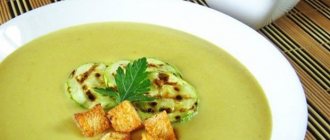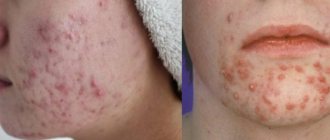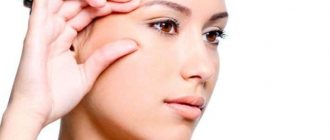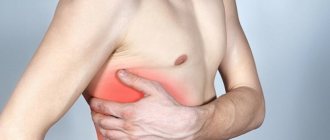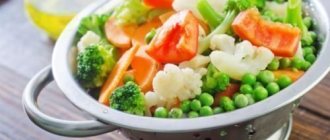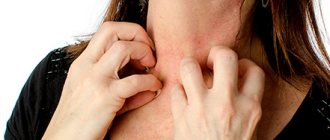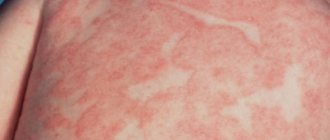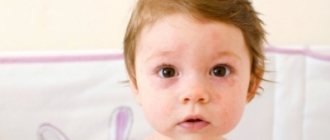What is demodicosis
Normally, demodex mites live on human skin. It has microscopic dimensions. If the number of individuals in a skin area does not exceed the norm, then this does not lead to pathology. In a healthy person, demodex does not penetrate the skin. Under certain conditions, the tick begins to actively reproduce. This is usually preceded by a decrease in immunity. Demodex penetrates deep into the skin and parasitizes there. A disease occurs - demodicosis.
In the skin form of the pathology, the mite lives in the sebaceous glands and feeds on their secretions. In the ocular form, the parasite penetrates the eyelash bulbs and eats their protein, keratin. Most often, demodex is found on the face and eyelids.
Mite waste products cause an allergic reaction. The cutaneous form of the pathology is manifested by the following symptoms:
- the appearance of acne;
- severe itching of the skin, especially in the evening and at night;
- shiny skin due to excess secretion of sebum;
- redness of the affected areas;
- proliferation of the wings of the nose.
In the ocular form of demodicosis, the following clinical manifestations are noted:
- eye fatigue;
- redness and inflammation of the skin on the eyelids;
- formation of a sticky film on eyelashes.
A tick can be detected using a special study. A skin scraping is taken for analysis and the number of parasites per 1 cm2 of epidermis is calculated. If the number of adult individuals is more than five, then the diagnosis is considered confirmed.
An integral part of treatment
Following a diet that excludes certain foods and dishes will reduce the affected area and stop the proliferation of parasites.
Special products included in the diet menu help destroy the tick and block its access to other healthy areas of the body.
Preference is given to the following products:
- fruits and vegetables;
- fermented milk products (ryazhenka, kefir);
- lean types of meat (turkey, chicken, beef);
- From fish it is better to choose cod, pike perch, navaga;
- porridges from various grains, especially rice and buckwheat;
- natural juices;
- nuts: almonds, hazelnuts;
- dried fruits (dried apricots, raisins);
- grain bread.
Glucose is the tick's favorite food. It promotes its active reproduction. The parasite's waste products predispose the body to allergic reactions, and allergenic foods further intensify this problem.
Products that can provoke allergic reactions are prohibited: honey, eggs, milk, citrus fruits. Avoid foods that disrupt metabolic processes in the body and clog pores: fatty, spicy, salty, smoked foods. You should not consume nicotine, alcohol, coffee or carbonated drinks.
As a result of a special diet, intestinal function improves, its microflora is restored and immunity is increased. All these conditions adversely affect the life activity of ticks.
Rosacea
Patients often believe that rosacea and demodicosis are the same disease. This is a misconception. Rosacea (rosacea) is not a parasitic pathology. The disease occurs due to dilation of facial blood vessels and is accompanied by reddish rashes on the face.
However, rosacea often provokes the development of demodicosis. Favorable conditions are created on the affected skin for increased mite activity. Therefore, these two pathologies often occur simultaneously in the same patient.
The principles of diet for demodicosis and rosacea are very similar. Both diseases are accompanied by skin inflammation and require limiting the same foods.
Causes and symptoms
The mite (Demodex, glandular acne, eyelash mite), which causes pathological processes, lives in the sebaceous glands and hair follicles of the skin.
Locations on the facial skin:
Insects can also live in eyebrows, eyelashes, and ears.
The most favorable areas for the development and functioning of ticks are places with active sebum secretion.
Demodex lives on the face of almost every person, feeding on dead skin cells. The disease occurs when mites penetrate the deep layers of the skin and lead to an inflammatory process.
With proper care of your skin, a person may never encounter such a disease. However, under certain circumstances, the tick becomes active and becomes visible to the eye.
Demodicosis is a pathology that entails consequences from both a medical and cosmetic point of view. In severe cases, unsightly scars and depressions remain on the face.
According to statistics, men suffer from demodicosis two times less often than women. This is explained by the fact that when shaving, the micron layer of the epidermis, where insects mainly live, is scraped off along with the stubble.
Treatment
For demodicosis of the face, doctors prescribe local anti-mite drugs (ointments, gels, shampoos), and for demodicosis of the eyelids - eye drops. They destroy parasites. A diet for demodicosis is necessary to maintain a good state of the immune system and skin, as well as to create unfavorable conditions for mite reproduction.
Is it possible to cure demodicosis with just one diet? This question often interests patients. Diet is a very important part of treatment, but it cannot replace drug therapy. It is impossible to get rid of ticks with proper nutrition alone.
Rosehip for demodicosis. Effective treatment of demodicosis with folk remedies
Demodicosis is a parasitic dermatological disease that has a chronic relapsing course.
The causative agent is a microscopic Demodex mite. It is similar to acne: a person has been treating acne for years, and during this time, the ears, etc.
Ignoring it leads to complex cosmetic defects. complex: medications, folk recipes, diet. What folk remedies can be prepared?
, eyebrows, nasolabial triangle, eyelids. The progression of the disease is accompanied by symptoms:
- the skin turns red;
- acne appears;
- itching is felt, which intensifies in the evening and at night;
- eyelids swell;
- eyelashes and hair fall out;
- hurts eyes;
- the dermis becomes oily, the pores expand;
- in advanced cases, visual acuity decreases.
To effectively get rid of ticks, various traditional methods will be useful. To combat the parasite, decoctions, infusions, vitamin mixtures and teas are used.
Only natural ingredients are used for preparation. This allows you to achieve long-lasting and lasting results and strengthen your overall immunity. Folk remedies are safe and do not contain dangerous chemical components. There is no aggressive effect on the affected skin.
REFERENCE! To achieve the best and fastest effect, be sure to normalize your diet. Fatty foods, smoked foods, and yeast should be excluded from it. Fill with fresh vegetables and herbs. Coffee should be replaced with herbal tea. Bio-yoghurts, dietary supplements, immunal for demodicosis are prohibited.
Treatment at home
The following is an extensive list of folk options for treating demodicosis in people. Before starting use, it is advisable to consult a dermatologist. A professional approach and recommendations will allow you to achieve better results.
Vitamin supplements to strengthen the immune system
Increasing the defenses of the human body is an important and necessary condition in the treatment of any ailments. For this purpose, you can drink a healing herbal mixture.
Components:
- black currant leaves;
- lemon balm or mint;
- calendula;
- fruits of sea buckthorn, rose hips, hawthorn;
- echinacea flower;
- calendula.
Take all herbs in equal proportions. Next 1-2 tbsp. pour boiling water over the collection, leave and drink 1 full glass 3 times a day.
Yellow clay for itching
One of the symptoms of demodicosis is itching, which interferes with sleep. To eliminate it, yellow clay is suitable.
- Dilute with water until the consistency of thick sour cream is formed.
- Apply to face at night.
- Secure with a bandage or mask.
- In the morning, wash off the mask with warm water.
- The result will appear in 5-10 days.
Soap mask
This is one of the easiest ways. To prepare, you only need regular laundry soap. Before going to bed, wash thoroughly, remove makeup and dust from your face.
Lather the soap in your hands, apply to your face, wait until dry. After an hour, apply another layer on the dried soap layer. Repeat 4-6 times, do not rinse in between. Leave the mask on overnight.
Black currant
Used for compresses. 4 tbsp. pour cold water over the raw material, boil, leave for 1-3 hours. Moisten a bandage in the resulting broth and apply to the affected areas.
Improving hygiene
Personal hygiene with demodicosis is very important. For washing and further care, it is recommended to use the following recipes.
- Chamomile and mint. Mix herbs. Take 4 tbsp. the resulting mixture, add hot water and leave. Use for washing.
- Alcohol infusion of calendula or wormwood (can be bought at a pharmacy). Moisten the cotton wool and wipe your face after washing.
- Alcohol compress. Half a glass of alcohol, 1 tsp salt, lemon juice. Soak the cloth in the liquid and apply to the skin for 5-7 minutes.
IMPORTANT! Any alcohol infusion can “burn” the epidermis. You cannot keep such compresses longer than the specified time. After the procedure, be sure to wash thoroughly.
Propolis
An alcohol infusion is suitable for treatment. A swab or cotton wool is moistened in it, then the treatment is carried out. Hold for 2 minutes, then rinse and apply acaricidal ointment (Ornidazole, Ichthyol).
Apply propolis 2 times a day. Repeat for 40-45 days. Thanks to the antibacterial properties of the tincture, the skin will heal.
Celandine
This is a powerful antiseptic. The plant does not kill mites, but effectively fights acne and eliminates inflammation. Celandine juice diluted with water (1:3) is excellent for morning and evening washes. The plant can also be used in the form of decoctions, tinctures and even creams.
Aloe
Used for compresses. Aloe helps relieve swelling of the eyelids and eliminates itching. For treatment you will need juice. It must be diluted in equal proportions with water. Next, moisten the cotton wool and apply to areas with severe itching for 20 minutes. Repeat 2-3 times a day.
Anabasis
Another name is hedgehog. Anabasis for demodicosis will reduce the number of parasites and reduce the severity of symptoms.
To prepare, take anabasis leaves and evaporate for 10 minutes. Apply the product to the skin. You can also wash your face with the resulting infusion.
What contributes to the development of the parasite
Let's try to understand the conditions conducive to the active reproduction of ticks. This will help to better understand the reasons for certain food restrictions provided for in the diet for demodicosis.
The following factors can provoke active reproduction of demodex:
- decreased immunity;
- increased secretion of the sebaceous glands;
- excessive consumption of fatty and sweet foods;
- intestinal diseases;
- skin inflammation;
- hormonal disorders.
The diet for demodicosis of the face or eyelids should be structured in such a way as to reduce the harmful effects of these factors.
Vitamins for demodicosis. Vitamins recommended for demodicosis
Tablets and drugs for the treatment of demodicosis
Demodicosis is a serious skin disease that affects 3 - 5% of the inhabitants of our planet. Demodicosis is very similar in appearance to acne. Many people do not pay enough attention to treating the disease, believing that it will go away on its own. But demodicosis as a disease is dangerous due to its complications, and therefore requires comprehensive and thorough treatment.
Demodicosis resembles acne
General information about demodicosis
Demodicosis is acarodermatitis. This term means that the disease is caused by ticks. The main causative agent of the disease is the acne gland or demodex. Parasites can live in humans and other mammals. The size of the mites ranges from 0.2 to 0.5 mm; they settle in the ducts of the sebaceous glands and near the hair follicles. Parasites are located on the skin of the face (eyelids, brow ridges, forehead, nasolabial folds, chin), in the external auditory canal, in the upper back, on the chest. Any person can become a carrier of a tick, but not all carriers develop demodicosis.
At the initial stage of the disease, formations similar to acne appear on the skin. The parasitic infection gradually develops, the affected areas increase in size. Squashing acne makes the situation worse because microorganisms begin to get into the open wounds, and the mites are pressed into the deeper layers of the skin.
It is very difficult to treat demodicosis; there are tablets for demodicosis, special ointments and hardware therapy methods.
Demodicosis is caused by the demodex mite.
Factors stimulating the development of the disease
Demodicosis usually appears in adolescence and often affects pregnant women. This indicates that the disease does not develop on its own. Infection occurs against the background of disturbances in the body. Activation of demodexes in the skin is provoked by various internal and external factors. Internal ones include:
- hormonal imbalances (increased or decreased secretion of sex hormones, adrenaline, thyroid hormones);
- weakened immunity (the immune system is unable to respond to a parasitic infection);
- diseases of the gastrointestinal tract.
External factors stimulating mite activity:
- hormonal ointments (their use reduces local skin immunity);
- excessive exposure to ultraviolet radiation;
- the effect of hot water and steam (bath procedures).
Swimming in too hot water activates parasitic mites
Symptoms of demodicosis
Demodectic mange is easily confused with acne and some other types of dermatitis. They are similar in symptoms. General manifestations of demodicosis:
- Skin inflammation.
- Red spots.
- Formation of nodules, bumps, and rosacea on the skin.
- Enlarged pores.
- Peeling.
Distinctive features of demodicosis:
- seasonal exacerbations (spring and autumn);
- itching, which worsens in the evenings and after exposure to heat.
Demodicosis often develops in the sebaceous glands on the skin of the eyelids. Symptoms of eyelid damage by Demodex cannot be confused with another disease. These include:
- Inflammation of the eyelids.
- The appearance of purulent nodules and crusts along the edges of the eyelids.
- Feeling dry.
- Eyelash loss.
- Clumping of eyelashes.
A prolonged inflammatory process on the eyelids can lead to the development of conjunctivitis.
If any of the listed symptoms appear on the skin, you should consult a dermatologist to accurately determine the type of disease.
Sticking of eyelashes is one of the manifestations of demodicosis
Forms of demodicosis of the skin
Demodicosis does not always manifest itself in the same way; sometimes the disease is complicated by certain factors. There are several forms of demodicosis.
- Erythematous-squamous demodicosis. Its symptoms are redness, peeling of the skin, the formation of scales and small papules.
- Papular demodicosis. Appears as large red papules.
- Papulopustular demodicosis. Blisters filled with pus (pustules) appear on the skin.
- Rosacea-like demodicosis. The external manifestations are similar to the disease rosacea - rosacea appears on the skin.
- Combined demodicosis. The most common form. Manifestations of all forms of demodicosis occur on the affected skin.
If you do not pay attention to the problem in time and do not start treatment, or try to deal with the manifestations of demodicosis on your own, you can get serious complications.
Rosacea-like demodicosis manifests itself as rosacea
General principles of diet
The following principles of therapeutic nutrition for demodicosis can be distinguished:
- Food should be rich in vitamins A, C and B, as well as proteins and amino acids. This will help strengthen the immune system.
- Food should contain sufficient fiber. Such food stimulates intestinal function and the removal of toxins.
- Dishes must be boiled or baked; frying is not allowed.
- The consumption of complex carbohydrates is recommended.
- You need to drink at least 1.5 liters of liquid per day.
- The patient should eat small meals and not overeat.
- Simple carbohydrates are limited. A sweet environment is favorable for tick reproduction.
- Food should be hypoallergenic and free of histamine and thyroxine. Products that promote the absorption of allergens are also limited.
- All products with artificial food additives are prohibited. They can also trigger allergies.
- Limit the consumption of salt and foods that irritate the stomach.
- Easily digestible carbohydrates are excluded from the diet, as they contribute to the inflammatory response.
- It is necessary to minimize the consumption of fats. Such foods contribute to excessive oiliness of the skin.
If the patient’s symptoms of demodicosis intensify, then it is necessary to switch to a dairy-vegetable diet. In this case, it is allowed to consume only fermented milk products and permitted vegetables and fruits. All other dishes should be excluded. This strict diet should be followed for about 7-10 days. Then you can gradually expand your diet.
Healthy recipes
First of all, nutrition for demodicosis of the facial skin should be balanced. The problem is consuming enough carbohydrates, since most carbohydrate sources must be eliminated from the diet.
You can compensate for the lack of sugars in your diet with vegetable salads and fruit salads (preferably local, seasonal).
Nutritious salad recipe (serves 3)
Boiled shrimp (red) do not need to be re-cooked. Freshly frozen pre-boil and cool.
Peel 200 g shrimp, cut into large slices. 3 medium-sized cucumbers, 200 g cabbage, radishes (5-7 medium-sized pieces) cut into small slices, place in a deep bowl and season with olive oil (1 tbsp). To stir thoroughly. Add shrimp last. Mix by shaking. Salt to taste.
Diet soup (based on a volume of 2 liters)
Rinse chicken meat (250 g), remove fascia. Cut into large cubes. Bring water to a boil, add meat to it and cook for 20 minutes. After cooking, drain the water and let the meat cool.
Medium-sized potatoes in the amount of 5 pcs. finely chop. Grind 1-2 medium-sized onions to a pulp in a blender or finely chop. Shred cabbage (0.5 medium head). Bring 2.2 liters of water (when ready, the volume will decrease to 2 liters) to a boil. Place potatoes in boiling water, add 1.5 cups of millet. Bring the water to a boil again and let stand for 10 minutes. Add cabbage and onion. Remove from heat and add meat to soup. As the soup cools, it acquires the consistency of thin porridge. Salt and pepper to taste.
Steam cutlets
From chicken meat, passed through a meat grinder along with a boiled onion and pre-soaked rye bread (1:1 ratio), dense medium-sized balls (5 cm in diameter, approximately) are formed. Leave on parchment paper for 15 minutes. After this time, steam for 30 minutes.
Following a diet is recommended during exacerbations of demodicosis to reduce skin contamination and reduce inflammation in it. After the symptoms have subsided, you can stick to the diet in a lighter form: moderately add drinks (tea, coffee), some types of fruits (bananas, grapes), and baked goods. This will have a beneficial effect on the nervous system. However, it is more advisable to follow a balanced low-carbohydrate diet also during periods of remission of the disease.
Authorized Products
Strengthening the body's immunity is one of the main goals of the diet for demodicosis. What can you eat? Dietary rules provide for fairly strict restrictions, and the list of permitted foods is small. However, this does not mean that nutrition for demodicosis should be poor. Those products that are approved for consumption contain all the necessary substances to maintain immunity. They are rich in vitamins, proteins and healthy carbohydrates.
The diet for facial demodicosis allows for a wide variety of vegetable dishes every day. It is allowed to eat zucchini, eggplant, squash, potatoes, any varieties of cabbage, onions, and garlic. The consumption of leafy vegetables (lettuce, asparagus), as well as herbs and legumes, is not limited. These foods are rich in fiber and do not contain allergens. Vegetables can be boiled, baked or steamed.
Hypoallergenic types of fruits and berries are allowed: peaches, nectarines, pears, black currants, gooseberries. They will help saturate the body with the vitamins necessary to maintain immunity.
For protein foods, it is recommended to eat lean fish, veal, rabbit meat, chicken breast and turkey fillet.
Nutritionists recommend eating cereals (buckwheat, oatmeal), crackers, whole grain bread, unsweetened dry biscuits, and pasta for demodicosis. These foods contain healthy complex carbohydrates.
Of the fats, it is allowed to consume mainly vegetable oils. As for butter, it can only be eaten in limited quantities.
To maintain normal intestinal microflora, fermented milk products are recommended: kefir (fat content no more than 0.1%), organic yogurt without additives, low-fat cottage cheese. Cheeses are prohibited for demodicosis. But you can eat the soy product tofu. It is rich in protein and tastes similar to cheese.
The diet includes drinking enough fluid. It is allowed to drink green tea, rosehip decoction, freshly squeezed juices from permitted vegetables and fruits, mineral water and chicory.
Nutrition rules
It is argued that demodicosis never occurs in some African tribes, despite their living conditions and relatively low level of hygiene (compared to the level of developed countries). A similar phenomenon was noted among the Eskimos and other inhabitants of the northern regions. The reason lies in the nature of the diet of these peoples. It consists of natural products with minimal processing. Consequently, nutrition for demodicosis should be as close as possible to the diet of these peoples.
Table of permitted products
The nutritional model for demodicosis, aimed at reducing the number of mites on the skin and its appendages, involves eating food that moderately inhibits the production of sebum. This deprives Demodex of its usual nutrient medium. Deterioration of living conditions suppresses the intensity of parasite reproduction and reduces its number.
Therapeutic nutrition for demodicosis has a beneficial effect on the entire body and improves intestinal function, and this, in turn, creates negative conditions for mites, as a result of which they simply die.
The main components of the diet for demodicosis
| Product | Maximum amount per day in grams |
| Lean sea and river fish (salmon, herring, krill, mackerel, tuna) | 200 |
| Fresh or frozen seafood (mussels, shrimp, crabs and lobsters, rapana). | 200-400 |
| Potato | 200 |
| Wild meat | 100-150 |
| Chicken meat | 300 |
| Greens, vegetables, fruits | 500-1000 |
| Cereals (buckwheat, rice, bulgur, lentils) | 250-750 |
Processing is allowed by steaming, by boiling, vegetables can be eaten raw.
Fruits should be present in the diet daily, but raisins, grapes, and dried dates should be avoided. Pineapple, mango, pears, apples, papaya do not provoke an increase in sebum secretion.
Among the drinks, mineral slightly carbonated and still waters, drinking water without impurities, juices from seasonal local berries and fruits, vegetable juices (cucumber, smoothies from cucumbers, cabbage and other “territorial” vegetables) are of particular benefit. Tomatoes, as well as tomato juice, must be eliminated from the diet.
What not to eat with demodicosis
The diet for demodex should be based on the consumption of minimally processed foods and without the use (or with limited use) of fats of animal and even plant origin. It is necessary to reduce the amount of table salt when cooking. Evidence of the negative effects of fats and salt can be seen in the “evolution” in the diet of the Inuit Eskimos. After becoming acquainted with a civilization that used oil and salt in cooking, the Inuit began to suffer from acne and demodectic mange, although before that they had practically never encountered skin diseases.
Modern research suggests the importance of excluding from the diet during demodicosis all alcoholic beverages and non-alcoholic kvass, all dairy products (except cottage cheese), chocolate, citrus fruits, and avocados. All hot dishes, as well as dishes with a high content of spices, are prohibited.
Eating foods containing a lot of simple carbohydrates has a negative effect on both the skin itself and the sebaceous glands, stimulating the production of sebum. At the same time, by increasing blood glucose levels, simple carbohydrates stimulate the production of insulin-like growth factor, which is responsible for the proliferation of sebaceous gland cells. Enlarged glands become home to mites, which become more and more numerous.
Among simple carbohydrates, the highest sugar content is found in sweet carbonated drinks (Coca-Cola, 7UP, Fanta, Sprite, etc.), chocolate bars, hot chocolate, and yogurts (including low-fat). Eggs, beef and pork contain animal proteins and large amounts of fat. By increasing the level of androgens on the one hand, they also increase the concentration of cholesterol in the blood on the other, which negatively affects the condition of the skin and aggravates the course of demodicosis.
Conditionally permitted products
These products should not be included in your daily menu. In the diet for demodicosis, they are not completely prohibited, but they can be eaten in small quantities and not daily.
Conditionally permitted products include:
- sweets: jam, sugar, jams, ice cream, sweets, confectionery;
- White rice;
- salt;
- semolina.
You should eat sweet foods with extreme caution. Such nutrition creates favorable conditions in the body for the reproduction of demodex.
Demodectic mange of the eye - diet
Breakfast is light: two boiled eggs, a sandwich with tea (bread should be made from wholemeal flour). Lunch: a fortified fruit salad is enough. Lunch: Fish soup, fish can be replaced with seafood, fresh vegetable salad. The afternoon snack can be replaced with a glass of kefir. Dinner can be varied with a portion of baked or stewed fish, to which you can add a broccoli salad.
Prohibited Products
Patients with demodicosis should completely avoid eating first courses with meat and mushroom broth. Only vegetable soups are allowed.
The following foods are also completely excluded from the diet:
- baked goods;
- red meat;
- mushrooms;
- pickles;
- sausages;
- fat meat;
- eggs;
- canned food;
- animal fats;
- cream;
- sour cream;
- high fat cottage cheese;
- seafood (except seaweed);
- marinades;
- smoked meats
Such food is heavy on the stomach and contains a lot of fat. This can provoke an exacerbation of demodicosis.
Citrus fruits are rich in ascorbic acid. However, they are contraindicated for patients with demodicosis, as they are highly allergenic. They should not be consumed even in small quantities. To saturate your body with vitamin C, you need to drink rosehip decoction daily or eat permitted fruits and berries.
For the same reason, red vegetables, fruits and berries are prohibited:
- carrot;
- tomatoes;
- red bell pepper;
- mango;
- red apples;
- strawberry;
- raspberries;
- Red Ribes;
- cranberry.
Cheeses are also prohibited, as they can cause allergies.
With demodicosis, spicy food is extremely harmful. Therefore, you need to completely eliminate spices, seasonings and mayonnaise.
It is also necessary to pay attention to the composition of the products. If food contains artificial food additives, then you should avoid eating it.
If you have demodicosis, you should not drink coffee, black tea, energy drinks or sweet soda. Such drinks promote the absorption of allergens. Alcohol in any dose is completely prohibited.
Drinking regime
Patients with demodicosis must prepare at least several liters of liquid for themselves every day. Doctors say that you need to drink as much as possible in order to quickly remove toxins from the body. Drinking plenty of fluids will also help prevent flaky spots on your body.
In addition to water and mineral water, rose hip decoction, green or herbal tea, milk, vegetable juices, berry or fruit compotes without added sugar, and fruit drinks are allowed to be consumed. Drinking soda, cocoa and coffee is strictly prohibited.
Despite the fact that diet is only a concomitant way to eliminate demodicosis, it should not be neglected. Otherwise, treatment may take years and lead to serious consequences.
Sample menu
How to create a sample menu for the week? The diet for demodicosis imposes many restrictions. However, even from a small list of permitted products you can create a varied and tasty menu.
You should eat at least 4 times a day. For breakfast, it is recommended to eat porridge with water and low-fat cottage cheese. For taste, you can add pieces of permitted fruits and berries. If a person is used to drinking coffee in the morning, then it can be replaced with green tea. This drink also promotes vigor and activity.
Light vegetable soups are prepared as a first course for lunch. For the main course, you can boil chicken breast, turkey fillet, rabbit or veal, and as a side dish prepare vegetable stew or mashed potatoes in water.
For an afternoon snack, you can eat fruit and drink a glass of kefir with crackers or unsweetened dry cookies.
For dinner, fish dishes with buckwheat or mashed potatoes are recommended. It is useful to prepare a vegetable salad. Only vegetable oil can be used as a dressing. For people prone to allergies, it is better to use boiled rather than fresh vegetables for salad.
Menu for the week
Meals need to be planned for demodicosis of the face for a week, and then strictly follow each point. So, the first diet option:
- Breakfast, which should never be skipped, as it provides the main boost of energy for the whole day, should consist of oatmeal or buckwheat. The main course should be washed down with green tea, preferably without sugar;
- For a snack, limit yourself to cottage cheese. You can eat some other fruit or add pieces of it to the cottage cheese;
- Make vegetable soup for lunch in advance. In addition, if you are not full, then allow yourself a piece of boiled meat;
- The next snack could be a glass of kefir or fermented baked milk;
- For dinner, make a vegetable salad. You can serve it with boiled meat or jellied fish;
- Kefir or fermented baked milk before bed will help improve digestion.
Remember that you don’t have to limit yourself in the amount of food you eat; you’re not losing weight, but fighting parasites. But try not to overeat, it is harmful to health and weakens the immune system. Here is another food option for a week for facial demodicosis, called “table No. 5”:
- Steam the omelette, but without the yolks. Wash it down with green tea, you can add milk;
- The snack consists of baked apples;
- As in the previous menu, lunch consists of soup, though rice rather than vegetable, and a portion of buckwheat porridge;
- Prepare a rosehip decoction in advance to drink during a snack. If desired, wash it down with a few crackers;
- Dinner consists of mashed potatoes, which can be supplemented with boiled fish. You can wash this down with green tea.
It is not necessary to strictly follow each of the points of these diets. If you wish, you can replace the porridge with potatoes and vice versa. Kefir can be replaced with fermented baked milk, cottage cheese or unsweetened yogurt. It all depends on your desire. But when planning your menu, do not forget to adhere to the basic principles of the diet.
To make your meals delicious, try including the following dishes:
- Baked apples. To prepare them, take a certain number of apples and wash them. Without cutting the fruit in half, remove the core and place the nuts in the empty space. Place a small piece of butter on top. You need to bake apples in the microwave, setting the timer for 7 minutes;
- Sea salad. Boil a certain amount of shrimp, chop them and mix them with your favorite vegetables. You need to season the salad with olive oil. Try to add as little salt as possible;
- Vegetable soup. Boil water in a saucepan and add diced potatoes. After 10 minutes, add more chopped onions, cabbage and carrots. 2 minutes before the end, add a few bay leaves and chopped herbs to the soup.
These nutritional principles can also be followed by a healthy person to avoid demodicosis and maintain a beautiful figure.
Thus, nutrition for facial demodicosis should be balanced. There is nothing difficult about following a diet, so try to eat properly during the entire treatment process.
For ocular form
Does the diet for demodicosis of the eyelids differ from the rules of nutrition for the skin form of the disease? After all, Demodex, which lives in the eye area, does not feed on subcutaneous fat. Is it necessary to exclude fats from the diet in this case?
The eyelids are also equipped with sebaceous glands. With demodicosis, the skin around the eyes is inflamed. It is extremely undesirable to increase the production of sebum; this can aggravate irritation of the eyelids.
Therefore, a patient with damage to the eyelids and eyelashes needs to adhere to the same food restrictions as with the cutaneous form of demodicosis. Excessive consumption of fats can lead to blockage of the sebaceous gland on the eyelid. This will cause severe inflammation and complicate the course of demodicosis.
Diet for demodicosis recipes. Diet for demodicosis: restrictions
- All caffeine-containing products go into the firebox. Coffee, chocolate, black and green tea, energy drinks, especially popular in Southeast Asia, are pure evil for demodicosis addicts. I have already talked about the serious problems, using my own example, that coffee addiction entails. However, for skin problems this is especially important.
Caffeine is a mild narcotic and a strong stimulant. When we drink our morning Nescafe and eat chocolates, the body receives a strong jolt, an urge to activity, a doping shock. The brain works more powerfully and faster, the heart beats louder, it’s as if someone is squeezing the kidneys dry every half hour, the nervous system is at its limit... But now we are interested in the face. And with him it’s no better. The sebaceous glands also receive a magical kick and begin to work harder, feverishly secreting a secret - lard. The tick is happy - there are a lot of tasty treats, fellow streptococci, you can multiply, multiply and further ruin the life of an unreasonable coffee lover. I sign with blood under every word below: as soon as I start drinking coffee daily or at least every other day, the condition of the skin on my face visibly worsens. An oily sheen appears, pores become clogged, minor inflammations, redness, etc. If I weren’t so experienced, if I didn’t know all the measures to prevent repeated attacks of demodex, the latter would torment me again and again with every coffee binge. I, a drug addict, sometimes have breakdowns, I admit. As usual, I can afford a cup or two of freshly brewed drink a week, no more. Green tea has a slightly milder effect, but still helps iron. There is no less caffeine in it, and even more, than in the killer instant Jacobs. - Reduce the number of sweets. For they, too, indulge the insect's prosperity.
- Chili pepper and other spiciness. Because the gastric mucosa will gradually become irritated and destroyed, which will aggravate the course of the disease. In addition, the pungent (passionate) taste warms up the dermis, like all organs, and demodex loves heat very much.
- Smoked meats. Likewise, they have a bad effect on the gastrointestinal tract.
- Salted and pickled foods. Same principle. In general, it is advisable to reduce the amount of salt to a minimum. This is not difficult if you gradually salt your regular food less intensely - no loss of taste is felt.
- Be careful with citrus fruits. Due to their eternally high allergenicity. The irritation will be as inappropriate for the patient as it is useful for the tick.
- Do not eat very hot food or drinks. For the same reason as in the previous paragraph. Let me note in passing that steam baths for the face, visiting saunas, hot baths and even being under the sun - all these pleasures also benefit the tick. This explains why I had my latest relapse after moving to Thailand.
- Less processed foods, fast food, instant noodles filled with preservatives, stabilizers, flavorings and other substances that should not be in normal home food.
You can and should eat tasty treats. Only very reasonable!
Diet duration
It is often difficult for patients to follow a fairly strict diet with demodicosis. How many days should you adhere to food restrictions? This question interests many.
The diet must be followed for at least 2 months. Nutritional rules must be followed not only during the acute period of demodicosis, but also for some time after recovery. As your condition improves, your diet can be gradually expanded. It must be remembered that demodicosis often recurs, and any disturbance in nutrition can lead to activation of the mite.
Reviews and results
Reviews from patients about the diet for facial demodicosis indicate that it is the nature of nutrition that largely determines the clinical manifestations of the disease and the duration of periods of remission.
- “... We discovered demodicosis when going to the hospital for acne. Extensive treatment was prescribed. In addition, I turned to my cosmetologist, who recommended special products for delicate skin care and specialized cosmetics. I had to give up a trip to the sea due to the need to avoid sunlight. I'm on a special diet. It seems to be simple, but for me it’s tiring, because I love sweets, chocolate, and now I had to give them up, and I also feel the restriction of salt. But what can’t you endure for the sake of your health”;
- “... I have been suffering from demodicosis for almost 3 years. The disease periodically worsens and subsides. I have tried many remedies, including folk remedies, but I cannot finally get rid of the parasites. At the first sign of exacerbation, I go on a diet. I tried to practice it constantly, but I can’t stand it, so I sit on it only during periods of exacerbation.”
